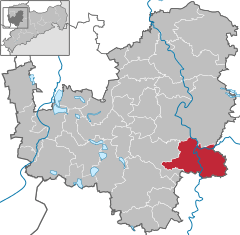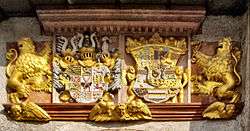Colditz
| Colditz | ||
|---|---|---|
|
City coat of arms at Colditz Castle | ||
| ||
 Colditz | ||
Location of Colditz within Leipzig district 
 | ||
| Coordinates: 51°07′N 12°49′E / 51.117°N 12.817°ECoordinates: 51°07′N 12°49′E / 51.117°N 12.817°E | ||
| Country | Germany | |
| State | Saxony | |
| District | Leipzig | |
| Government | ||
| • Mayor | Manfred Heinz (FDP) | |
| Area | ||
| • Total | 83.55 km2 (32.26 sq mi) | |
| Population (2015-12-31)[1] | ||
| • Total | 8,752 | |
| • Density | 100/km2 (270/sq mi) | |
| Time zone | CET/CEST (UTC+1/+2) | |
| Postal codes | 04680 | |
| Dialling codes | 034381 | |
| Vehicle registration | L | |
| Website | www.colditz.de | |
Colditz (German pronunciation: [ˈkɔldɪts]) is a town in Saxony, Germany, on the banks of the river Zwickauer Mulde near Leipzig. The town had a population of 5,188 in 2005.
The town is best known for Colditz Castle, which was used as a prisoner-of-war camp in the First World War and again in the Second World War, when it was titled Oflag IV-C.
History
The first record of a settlement, located on the River Mulde, called Cholidistcha dates to the year 1046.[2] In 1083, Henry IV recommended that Markgraf Wiprecht of Groitzsch build a castle on the cliff above the river. In the 12th century, houses were built around the marketplace and St. Nicholas's Church was built. In 1265, town rights were granted by the ruler. In 1504, the baker accidentally set Colditz on fire and the city hall, church, castle and a large part of the town went up in flames. In 1506, reconstruction began and new buildings were raised around the rear castle courtyard.
In the 17th century, a textile and weaving industry developed. In the 18th century, clay from the Colditz area started to be used in the Meissen porcelain factory that was established in 1710 by the Elector of Saxony, Augustus the Strong. In 1804 a ceramics factory was established in Colditz by Thomsberger & Hermann.
In the Second World War, the town did not suffer any damage. The town became headquarters for the military personnel guarding the prisoner of war camp for officers, Oflag IV-C, that had been established in the castle. On 14 April 1945, the U.S. Army entered the town and freed the prisoners. However, under agreements signed at the Yalta Conference, the Americans withdrew and were replaced by Soviet occupation forces late in June 1945. As a result, Colditz and the entire state of Saxony became part of East Germany. In 1958, a factory manufacturing porcelain was established [2]
Since German reunification in 1990, efforts have been made to increase visits by tourists. The castle was restored and has become a much visited museum.[3] The great flood of August 2002 caused some damage to the old town, but it has since been restored.
Sights
- Colditz Castle
- St. Nicholas Church – Originally built in the middle of the 12th century.
- Old Marketplace – Markt, the houses at #13 and #21 were built around 1600.[4]
- Lower Market #3 – Untermarkt 3 – a Gothic house with steep gabled roof with date 1564.
- Johann David Köhler house – the grandfather of information science and a grandfather of library science was born here 16 January 1684.
Twin towns
Colditz is twinned with
Transport
In the vicinity of the city are two airports: Leipzig-Altenburg Airport (26 km) and Leipzig/Halle Airport (52 km)
Wartime dramatisations
The story of the wartime prisoners at Oflag IV-C was documented by Patrick Robert ("Pat") Reid in his books The Colditz Story and The Latter Days At Colditz, and the former was used as the basis for a 1955 film directed by Guy Hamilton. In the early 1970s the BBC broadcast a series, Colditz, created by Brian Degas and Gerard Glaister, with Reid as technical advisor. Beginning in 1973 a board game Escape from Colditz was marketed by Parker Brothers, followed by a computer game in 1991.
Sons and daughters of the city

- Johann David Köhler (1684-1755), historian and numismatic
- Paul Nitsche (1876-1948), psychiatrist and one of the men responsible for the medical murders during the Nazi era
- Ernst Bergmann (1881-1945), professor of philosophy and pedagogy as well as a committed national socialist
- Werner Gruner (1904-1995), mechanical engineer and university lecturer
- Alfred Hoppe (1906-1985), painter and graphic artist
- Jürgen Schumann (1940-1977), pilot of the Lufthansa, victim of the Red Army Faction
- Clemens Pickel (born 1961), bishop of the diocese of Saratov in Russia
Other people with a relationship to the city
- Christian Führer (1943-2014), priest in Colditz from 1968 to 1980, an initiator of the peaceful revolution in the GDR as pastor of the Nikolaikirche in Leipzig
- Ernst, Elector of Saxony (1441-1486), died on 26 August 1486 near Colditz, when he fell from his horse on a ride
References
- ↑ "Aktuelle Einwohnerzahlen nach Gemeinden 2015] (Einwohnerzahlen auf Grundlage des Zensus 2011)" (PDF). Statistisches Landesamt des Freistaates Sachsen (in German). July 2016.
- 1 2 "den offiziellen Seiten". Stadt Colditz. Retrieved 2008-07-13.
- ↑ Visiting Colditz Castle
- ↑ Guide to Colditz (in German)
- Michael Booker, Collecting Colditz and Its Secrets, page 32.
- Eric J. Narveson, Prison Citadel, pp. 36–37.
- Pat Reid, Colditz: The Full Story, pp. 124, 259-263.
- Georg Martin Schädlich, Tales from Colditz Castle, pp. 4–6, 27, 61, 63, 91-101.
- Colditz in the Digital Historic Index of Places in Saxony (Digitalen Historischen Ortsverzeichnis von Sachsen)
External links
| Wikimedia Commons has media related to Colditz. |
- Official website (German)
- Exposé on Colditz Castle: Description of the Building from the Colditz tourism webpage. Retrieved March 19, 2005.
- Visiting information for Colditz Castle
- German army records indicate the camp was in existence from September 1939 until April 1945.
- ColditzCastle.Net — Premier information resource on the internet for Colditz Oflag IVC.
- VirtualColditz.com — Videos and photos of Colditz Castle as it is today.
| Grimma | Leisnig | ||
| Bad Lausick | |
Hartha | |
| |||
| | |||
| Königsfeld | Zettlitz | Geringswalde |

